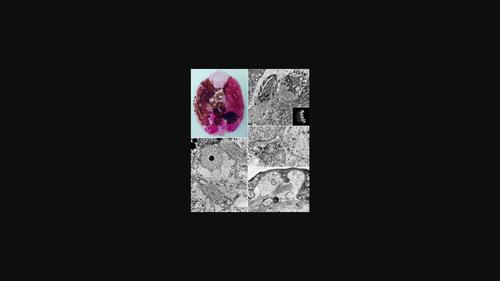当前位置:
X-MOL 学术
›
J. Morphol.
›
论文详情
Our official English website, www.x-mol.net, welcomes your feedback! (Note: you will need to create a separate account there.)
Microanatomy and ultrastructure of the nervous system of adult Renicola parvicaudatus (Digenea: Renicolidae)
Journal of Morphology ( IF 1.5 ) Pub Date : 2024-01-03 , DOI: 10.1002/jmor.21672 Sofia A. Denisova 1 , Sergei V. Shchenkov 1 , Vladimir V. Lebedenkov 1
Journal of Morphology ( IF 1.5 ) Pub Date : 2024-01-03 , DOI: 10.1002/jmor.21672 Sofia A. Denisova 1 , Sergei V. Shchenkov 1 , Vladimir V. Lebedenkov 1
Affiliation

|
The digenean complex life cycle includes various morphological forms with different locomotory and behavioral activities, and the functional specialization of their nervous system is of importance for the transmission of these parasites. Adult digeneans acquire many adaptive features associated with the final settlement in a vertebrate host. Our study describes the general morphology and ultrastructure of the nervous system of the adult renicolid digenean Renicola parvicaudatus parasitizing the renal tubules of herring gulls. Using immunocytochemical and electron microscopic methods, we identified the distinctive characteristics of ganglia and synapses in the studied species. A comparative analysis of the organization of the nervous system of adult individuals and their continuously-swimming stylet cercariae revealed a number of stage-related differences in the composition of ganglia, the distribution of serotonin- and FMRFamide-immunoreactive neurons, the cytomorphology of neuron somata and free sensory endings. Thus, in adults, the presence of FMRFamide-positive neuron somata, accessory muscle bundles in the ganglionic cortex, and eight types of neuronal vesicles was detected, but no glia-like elements were identified. Their neurons are characterized by a larger volume of cytoplasm and also show greater ultrastructural diversity. Although the sensory papillae of adults do not vary in their external morphology as much as those of larvae, their sensory bulbs are more diverse in cytomorphology. Following our previous data on the “support” cell processes related to various tissues of the larvae and considered as glia-like structures, we also briefly present the identified features of the parenchyma, attachment organs and excretory system of adult individuals. The excretory system of adult R. parvicaudatus is characterized by the presence of unique terminal cells with several flame tufts, which are not typical either for the larvae of this species or for other digeneans studied so far. We also used molecular phylogenetic analysis to clarify species identification.
中文翻译:

成虫 Renicola parvicaudatus 神经系统的显微解剖和超微结构(Digenea:Renicolidae)
双殖系复杂的生命周期包括具有不同运动和行为活动的各种形态形式,其神经系统的功能特化对于这些寄生虫的传播非常重要。成年双殖系动物获得了许多与在脊椎动物宿主中最终定居相关的适应性特征。我们的研究描述了寄生在鲱鸥肾小管的成年 Renicolid digenean Renicola parvicaudatus神经系统的一般形态和超微结构。使用免疫细胞化学和电子显微镜方法,我们确定了所研究物种的神经节和突触的独特特征。对成人神经系统组织及其持续游动的尾蚴的比较分析揭示了神经节组成、血清素和 FMRFamide 免疫反应性神经元的分布、神经元胞体的细胞形态学等方面的许多阶段相关差异。和自由的感官结局。因此,在成人中,检测到 FMRFamide 阳性神经元胞体、神经节皮层中的辅助肌束和八种类型的神经元囊泡的存在,但没有鉴定出神经胶质样元件。它们的神经元的特点是细胞质体积更大,并且还表现出更大的超微结构多样性。尽管成虫的感觉乳头的外部形态变化不如幼虫的感觉乳头大,但它们的感觉球的细胞形态更加多样化。根据我们之前关于与幼虫各种组织相关并被认为是神经胶质样结构的“支持”细胞过程的数据,我们还简要介绍了成年个体的实质、附着器官和排泄系统的已识别特征。成虫R. parvicaudatus的排泄系统的特征是存在带有多个火焰簇的独特末端细胞,这对于该物种的幼虫或迄今为止研究的其他双殖纲动物来说并不典型。我们还使用分子系统发育分析来阐明物种鉴定。
更新日期:2024-01-04
中文翻译:

成虫 Renicola parvicaudatus 神经系统的显微解剖和超微结构(Digenea:Renicolidae)
双殖系复杂的生命周期包括具有不同运动和行为活动的各种形态形式,其神经系统的功能特化对于这些寄生虫的传播非常重要。成年双殖系动物获得了许多与在脊椎动物宿主中最终定居相关的适应性特征。我们的研究描述了寄生在鲱鸥肾小管的成年 Renicolid digenean Renicola parvicaudatus神经系统的一般形态和超微结构。使用免疫细胞化学和电子显微镜方法,我们确定了所研究物种的神经节和突触的独特特征。对成人神经系统组织及其持续游动的尾蚴的比较分析揭示了神经节组成、血清素和 FMRFamide 免疫反应性神经元的分布、神经元胞体的细胞形态学等方面的许多阶段相关差异。和自由的感官结局。因此,在成人中,检测到 FMRFamide 阳性神经元胞体、神经节皮层中的辅助肌束和八种类型的神经元囊泡的存在,但没有鉴定出神经胶质样元件。它们的神经元的特点是细胞质体积更大,并且还表现出更大的超微结构多样性。尽管成虫的感觉乳头的外部形态变化不如幼虫的感觉乳头大,但它们的感觉球的细胞形态更加多样化。根据我们之前关于与幼虫各种组织相关并被认为是神经胶质样结构的“支持”细胞过程的数据,我们还简要介绍了成年个体的实质、附着器官和排泄系统的已识别特征。成虫R. parvicaudatus的排泄系统的特征是存在带有多个火焰簇的独特末端细胞,这对于该物种的幼虫或迄今为止研究的其他双殖纲动物来说并不典型。我们还使用分子系统发育分析来阐明物种鉴定。



























 京公网安备 11010802027423号
京公网安备 11010802027423号